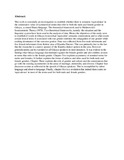| dc.contributor.author | Munyiri, Judith N | |
| dc.date.accessioned | 2013-05-02T09:06:02Z | |
| dc.date.available | 2013-05-02T09:06:02Z | |
| dc.date.issued | 2006-06 | |
| dc.identifier.citation | Munyiri, J. N.(2006). Language and gender: a case study of the Ki-Kabete variety of Gikuyu | en |
| dc.identifier.uri | http://erepository.uonbi.ac.ke:8080/xmlui/handle/123456789/18320 | |
| dc.description | MA(Linguistics) - Thesis | en |
| dc.description.abstract | This work is essentially an investigation to establish whether there is semantic
'equivalence' in the connotative value of symmetrical terms that refer to both the male
and female gender in Gikuyu, a central Bantu language. The theoretical framework used
is Malinowski's Sociosemiotic Theory (1978). Two theoretical frameworks, namely: the
situation and the linguistic system have been used in the analysis of data.
Hence the objectives of the study were to establish if words in Gikuyu lexicon had
'equivalent' semantic connotations and to what extent certain lexical items if associated
with one gender reinforce the subjugation of one gender while exalting dominance of the
converse gender.
Data was collected from five male informants and five female informants from Kabete
area of Kiambu District. This was primarily due to the fact that the researcher is a native
speaker of the Ki-Kiambu dialect spoken in the area. However generalizations can be
extended to all Gikuyu speakers in most instances. It was evident in the findings that
Gikuyu language discriminates against the female gender and also exhibits sexism in
terms that refer to the female gender.
Chapter Two explains asymmetry of nominal terms for males and females. It further
explains the forms of address and titles used for both male and female genders.
Chapter Three explains the role of gender and culture and the connotations that go with
the existing asymmetries in the areas of marriage, immorality and divorce. Chapter four
discusses sexism as reflected in the speech of Gikuyu speakers. This is exemplified by
taboo language and abusive-language. Finally, chapter five is a revelation that indeed
there exists no 'equivalence' inmost of the terms used for both male and female genders, | en |
| dc.description.sponsorship | University of Nairobi | en |
| dc.language.iso | en | en |
| dc.subject | Language and gender | en |
| dc.subject | Ki-Kabete | en |
| dc.subject | Gikuyu | en |
| dc.title | Language and gender: a case study of the Ki-Kabete variety of Gikuyu | en |
| dc.type | Thesis | en |
| local.publisher | Department of Linguistic and African Languages, University of Nairobi | en |

